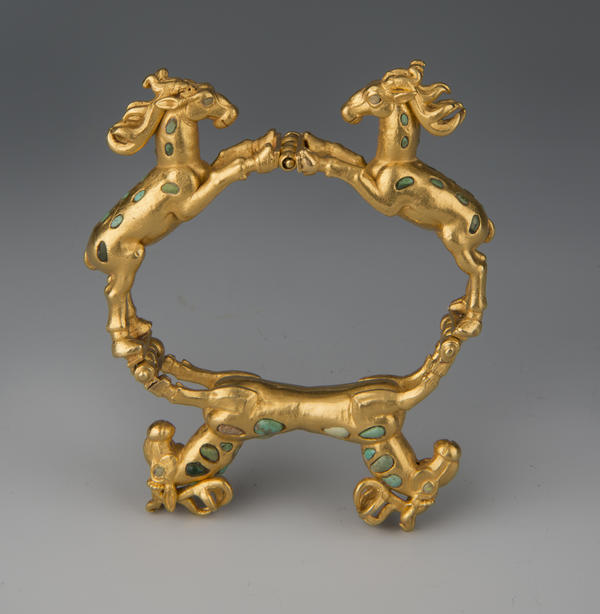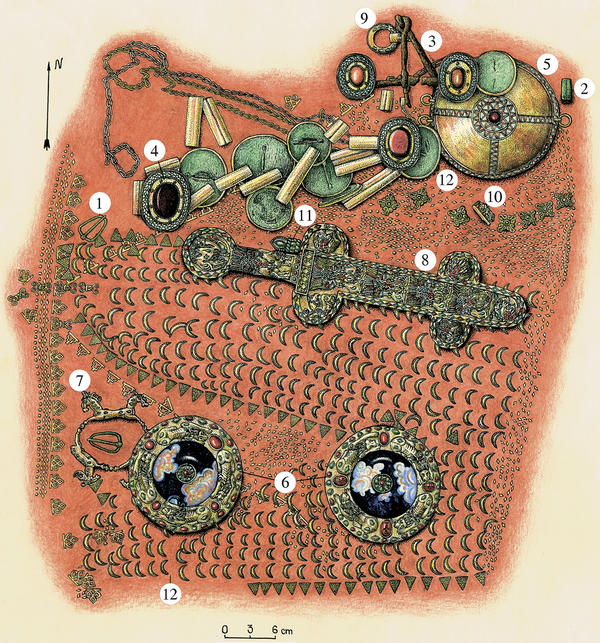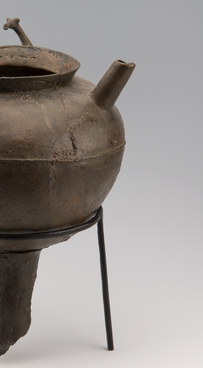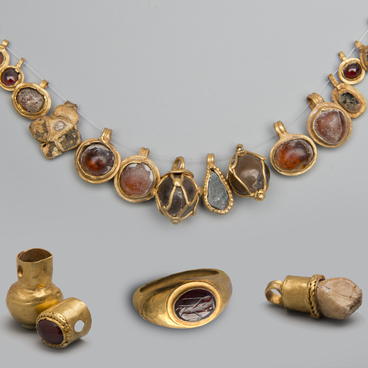In 1986, during archaeological research on the south-eastern outskirts of the city of Azov, in the area of a dacha community, there was discovered a very rich burial complex of the Sarmatian period. The burial mound had been robbed and completely destroyed in ancient times. However, the Primorsky archaeological detachment of the Azov Museum of Local History under the direction of E.I. Bespaly carefully studied the burial complex. And in the cache, which had been arranged in the grave and carefully masked before the burial, the archaeologists discovered valuable ancient objects — jewels. The dagger with a scabbard, bracelet, belt, set of horse harness and horse cape are now on view at the Azov museum-reserve.
Bracelet
Creation period
last quarter of the 1st century CE
Dimensions
9.5х11.5х 2.1 cm
Technique
gold, turquoise, coral, glass, gilding, hammering, chasing, inlaying, polishing, soldering, faux granulation
Collection
Exhibition
15
Open in app#10
#6
The massive golden bracelet made of running sika deer figures lay in the southwestern part of the cache. The decoration consists of figures of two sika deer and a double protome of these animals — the so-called image of the front part of an animal’s body or the upper part of a human figure. The bracelet is inlaid with decorative inserts of turquoise, coral and glass; with them, the artist outlined the spots and eyes of the deer.
Lay-out of the “Dachi” mound cache
#7
The ancient artist made the extreme unit-cast, heavy figures using the lost-wax casting technique. To do this, first they would make a version of the future product from wax, then they created a refractory form after it from a special mass. Then they would heat it, the wax melted and poured out, and the cleared cavity was filled with hot metal. Then the figure was allowed to completely cool down and pulled out of the mould. But they used a different technique in the manufacture of these animals’ the double protome. The product, hollow inside, was assembled from individual fragments.
#2
The artist carefully worked out the details of the jewel. The deer heads are crowned with branching horns. Both the paws and horns of all figures are soldered, and the seams in the areas where the horns were soldered are covered by a wreath made of ribbed wire. The master may have soldered gold granules in a strip one by one. The ancient artist even thought out a most fine detail — the staple-shaped pin that locks in the bracelet is fixed and cannot be lost.
Double sika deer protome
#11
Ministry of Culture of the Russian Federation
read morehide
00:00
00:00
1x
Bracelet
Creation period
last quarter of the 1st century CE
Dimensions
9.5х11.5х 2.1 cm
Technique
gold, turquoise, coral, glass, gilding, hammering, chasing, inlaying, polishing, soldering, faux granulation
Collection
Exhibition
15
Open in app
Share





